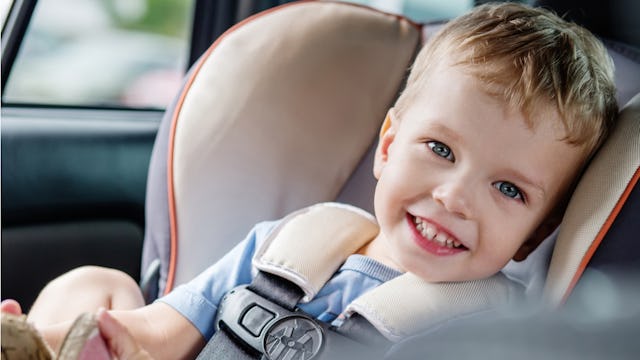Here Are The AAP’s New Car Seat Guidelines

They’re providing concise info on seats for every age group
The American Academy of Pediatrics recently updated its guidelines on car seat usage and safety. The concise information is helping parents breathe a sigh of relief, because let’s be real — what parenting choice is more confusing and full of conflicting information than car seat shopping?
The AAP has you covered on everything from what type of car seat is right for each age group, safe installation for both rear-facing and forward-facing seats, and clear information on booster seat use for older kids.
This chart breaks it down nicely as far as who belongs in what kind of seat and for how long, and is a great aide to have handy for a trip to Target to buy a seat. Additionally, the AAP’s complete recommendations and FAQs cover any question a parent could possibly have about safe and age-appropriate car seat use.
Image via AAP
Once you have the right seat, the CDC has a graphic to help with proper installation.
Image via CDC
The AAP removed any ambiguity surrounding when a child should remain rear-facing and when it’s OK to switch to forward-facing. The guidelines clearly state that, “All infants and toddlers should ride in a rear-facing seat until they are at least 2 years of age or, preferably, until they reach the highest weight or height allowed by their car seat manufacturer.”
Once they outgrow the ability to rear-face, toddlers and preschoolers should remain in a forward-facing convertible car seat with a five-point harness for as long as possible, aka, until the child hits the weight or height limit allowed on the seat.
As far as the transition from forward-facing convertible seat to booster, the AAP issued the following guidelines to let parents know when a child is ready to make the move:
- He reaches the top weight or height allowed for his seat with a harness. (These limits are listed on the seat and also included in the instruction booklet).
- His shoulders are above the top harness slots.
- The tops of his ears have reached the top of the seat.
The group also makes clear how long a child should remain in a booster seat, a huge argument with my school-age kids who think they’re “too big” to need a booster (they’re not). A child needs a belt-positioning booster seat until they surpass 4’9″ tall. The AAP says that typically happens between ages 8-12, but that most kids won’t fit safely in most vehicles without a booster until age 10 or 11.
They also note that all kids under age 13 belong in the back seat, and from my experience with a fifth grader, that’s a point of contention for parents and grade schoolers. Now you can tell them the official source says they have to be a teenager to ride in the passenger seat. No matter how much they whine about wanting to be able to change the music.
Keeping up-to-date on all the most recent information about every type of safety concern for kids is, no doubt, exhausting. But when it comes to things like the correct car seat to use for your child’s age and size, it’s crucial to keep up with the most current info.
If you read the guidelines and discovered you’re in need of a new seat, the AAP has these helpful tips:
- No one seat is the “best” or “safest.” The best seat is the one that fits your child’s size, is correctly installed, fits well in your vehicle, and is used properly every time you drive.
- Don’t decide by price alone. A higher price does not mean the seat is safer or easier to use.
- Avoid used seats if you don’t know the seat’s history.
This article was originally published on